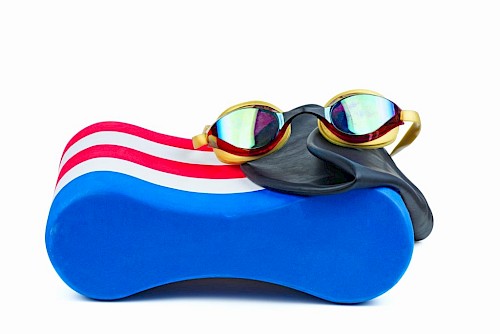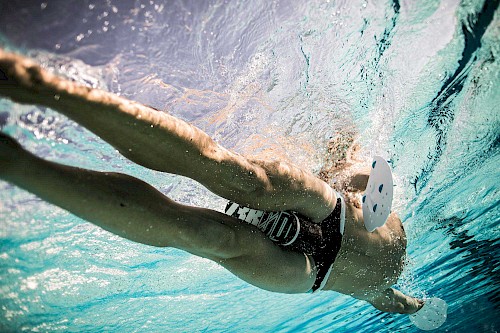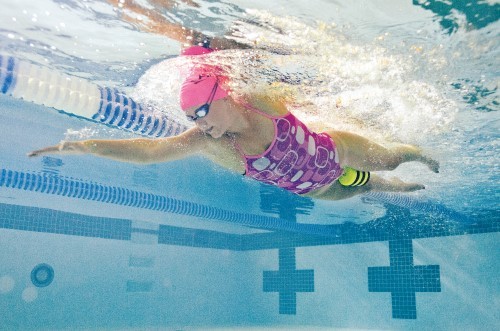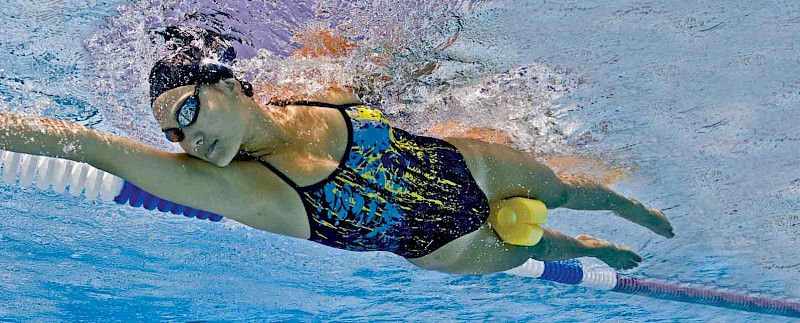Swimming has equipment that helps improve the technical gesture. The most universal of them all is the pull buoy, the real star of pool training. But let's see how to make the most of it.

The market offers a wide variety of training tools: there are corrective ones, which as such should not be used indiscriminately because not everyone and everyone has the same technical needs on which to intervene; and then there are those that develop muscular overload, which should be used when the technical gesture is structured enough to support them (without running the risk of causing joint and muscle damage) or when you want to facilitate specific technique exercises.
Free swimming lanes often have limitations on the use of equipment (e.g. paddles and fins), but there is one that always gets a pass and has become a regular training companion. We are talking about the pull buoy.
The pull buoy is a small float that is... truly addictive! Those who find particular benefit in using the pull buoy is because they do not have a particularly good posture from a hydrodynamic point of view: the tool recreates a more effective waterline by decreasing friction (it lifts the pelvis). Simply using it, however, does not correct the technical gesture, in fact the exact opposite usually happens.
Is the pull buoy only for less effort?
Those who start swimming training as adults often have difficulty in controlling their posture and especially in managing their legs (men more so than women, due to musculature and structure) and the pull buoy is the cure for less fatigue, the solution to swimming training without suffering too much.
With the pull buoy, in fact, you can develop important volumes at medium-low intensities by parking your brain on the edge of the pool, without thinking about what you are doing.

But training means crossing the line drawn by habit, then creating both physical and mental stimuli to structure growth. The mind must be in the here and now to store information and process it, to identify limits and move them further and further. Escape routes from fatigue are therefore not part of these concepts, and when the pull becomes just a comfortable armchair on which to laze about, it is better to intervene by supplementing or replacing it with other equipment, or by structuring dynamic workouts that open the door to discomfort.
This does not mean that one should deprive oneself of it, but simply give it a different place and reduce its importance.
What swimming gear is (really) for
The tools are intended to
- destabilise
- deprive part of the propulsion in order to concentrate on less obvious but no less important details
- develop a greater application of force
- achieve different levels of fatigue tolerance from time to time
- technically improve swimming details

Through the (non-random) use of more than one piece of equipment, a richer and more varied motor multilaterality is developed, thanks to the acquisition of multiple skills.
The pull buoy was created with the aim of limiting the use of the lower limbs (deprivation) by overloading the upper limbs. If this purpose is supplemented by others that are the result of imagination and creativity (provided there is a route designed with a purpose), the training is not monotonous and certainly becomes more fun.
Ideas for swimming training with the pull buoy
- you can work on progressions or intensity variations
- 12×100 in external progression from 1st to 3rd
- 500m continuous, inserting for each 100: 50m easy/25m sustained/25m easy
- or you can structure series focusing on controlling breathing frequencies
12×50 with a change of breathing every 50 according to ability (3/5/7/9 - 2/4/6/8 - 3/5/2/4...)
- those who have already mastered the posture can create a few more problems for themselves by doing series consisting of short distances with the addition of an ankle lace (or crossing the legs) to develop the effectiveness of the force applied to the underwater phase of the stroke
- legs are often used unconsciously with the pull buoy too, so why not emphasise the action by making it conscious, through series consisting of short distances? The pull buoy, in fact, limits the excursion of the stroke and conditions the movement, and this exercise can create a good focus for those who have difficulties in leg-arm coordination and in controlling the motor compensations of the legs
- you can play on decreasing rests while keeping the intensity constant, or try to keep the rest constant by increasing the intensity
4 series consisting of 4×100 with a 5" decreasing restart every 100 m, with the aim of always maintaining a 15" pause (e.g. restart at 1'50"-1'45"-1'40"-1'35" trying to always maintain a 15" lower pace than the restart)
- you can alternate stretches with the pull on the backstroke with the aim of limiting the swinging of the legs and focusing on abdominal hold, or short breaststroke stretches with the pull to maximise the action of the first stroke
These are just small examples which must then obviously be contextualised, customised and finalised with a general idea of programming. Having fun in training does not mean not exerting yourself, quite the contrary. Fatigue, however, must not be an end in itself, but must become the main ingredient for savouring the taste of achievements.
